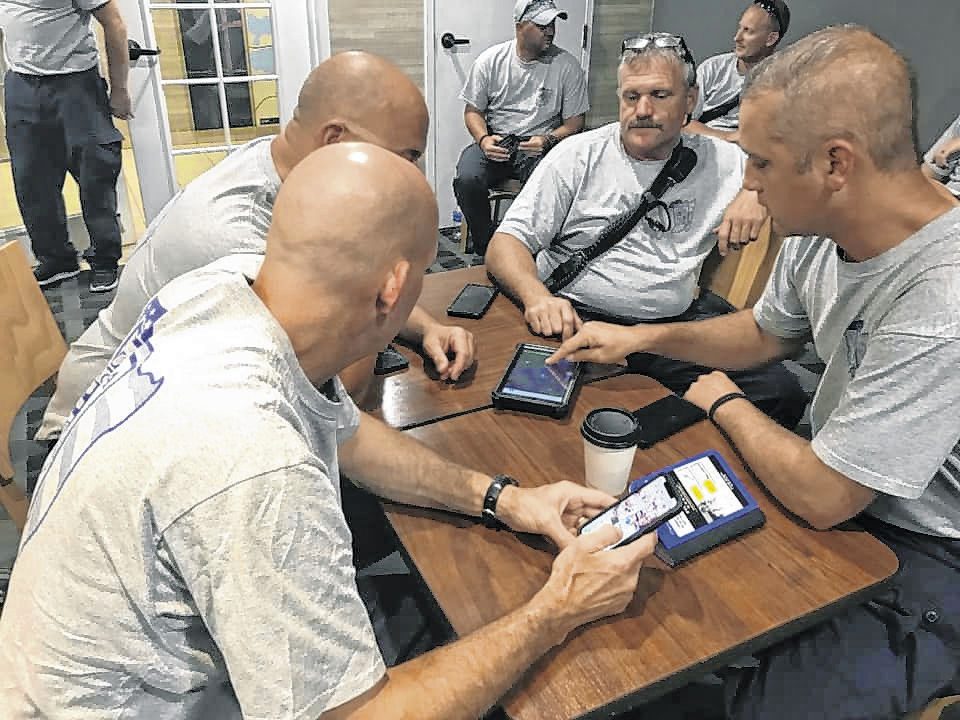Dozens of Indiana firefighters, including four from Johnson County, and about five local utility workers are waiting to see where they will be needed and what work is ahead as the first major hurricane of the season neared Florida’s coast and moved north.
Franklin Fire Department Chief Dan McElyea, Bargersville firefighter Sean Campbell, Greenwood firefighter Justin Laraway and White River Township firefighter Mike Combs have traveled south and are waiting to help communities in the aftermath of Hurricane Dorian. Johnson County firefighter Mike Pruitt is spokesman for the task force of Indiana first responders who are called to help when disaster strikes, but is not traveling with the group on this trip.
Eighty members of Task Force One and six contractors — drivers and mechanics — were staged in the Orlando area until they receive orders from the federal government to report to another area, Pruitt said. Much depends on where the hurricane causes damage, and the storm’s path had been shifting since the team was deployed.
[sc:text-divider text-divider-title=”Story continues below gallery” ]
“If the locals put out a request for more service, whether that be in Florida or Georgia or the Carolinas, those states reach out to the federal level, and (the federal government) decides where we go,” Pruitt said.
In the meantime, the rescuers are training, or reviewing what they have already learned, such as water rescues and data collection, Pruitt said.
A lot of their focus has been on a new GIS system they will use for the first time in the field, Campbell said.
Survey123 allows rescuers to upload information and photos in real-time so supervisors and government officials can know what they’re doing, when and where, and determine what and how much aid is needed, he said.
This is Campbell’s second deployment with the task force, and it is much different than his last, he said on the phone from Florida on Tuesday.
He was part of the group that was deployed last year to Wilmington, N.C. to help in the aftermath of Hurricane Florence.
“We had a good idea of where that storm was going, and they deployed us right into the eye. With this one, nobody really knows where it’s going to come in or where it’s going to hit, so we’ve had to be prepared for everything. At times, forecasters are saying it might be a Category 5. Now it’s kind of losing its steam,” Campbell said.
As the hurricane moves, they may be re-positioned, he said.
“We’re diligent and prepared for whatever this storm may bring,” Campbell said.
One possibility is that Task Force One is sent back to Indiana without being asked to render any aid, Pruitt said.
“I look back on the storms we’ve responded on, and it’s not a huge percentage, but it’s some,” he said. “We were staged and the storm either weakened or changed course or the locals did not need those resources. (But) we’re there and we’re ready to respond if we’re needed.”
About five local utility workers with Duke Energy also headed south late last week to help restore power in the aftermath of the monster storm, which as of Monday morning had neared Category 5 strength before weakening.
As it inched closer to the United States, it seemed to be tracking north, meaning the hurricane itself may not make landfall in Florida as originally expected.
“Just because it doesn’t make landfall doesn’t mean there won’t be winds and torrential rains that could wreak quite a bit of havoc on the areas we serve,” said Chip Orben, Duke’s government and community relations manager. “I don’t envision they will be sent back anytime soon.”
About 700 employees from three states, including Indiana, were deployed to Macon, Ga. on Friday. They have since been split up among areas in Florida with a high number of Duke customers, Orben said. Some are stationed in Gainesville, Fla., while others were sent to The Villages, northwest of Orlando, he said.
As the storm’s path shifted, residents in other states started considering evacuation plans, and workers were considering where they might be needed.
More than 800,000 in South Carolina alone, and a half-million in Georgia, were warned to evacuate for fear Dorian could bring life-threatening storm-surge flooding even if the hurricane’s center stayed offshore, as forecast. Several large airports announced closings, and hundreds of flights were canceled.





